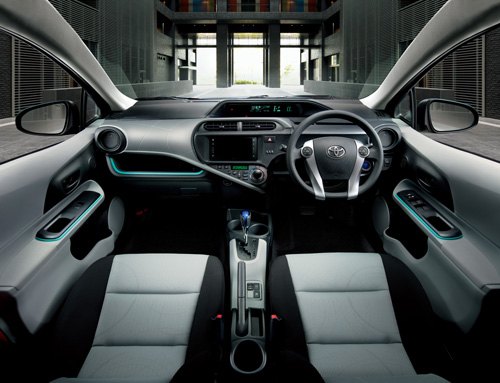World's Most Fuel Efficient Hybrid" Goes On Sale In Japan

On the second day of Christmas, Toyota officially launched what will be known as the “Aqua” in Japan, or the “Prius C” in the U.S. and elsewhere. It will also be known as “the world’s most fuel efficient hybrid car.” At least that’s what Reuters calls it.
TTAC’s Best & Brightest have known the car since mid November, personally presented by Toyota’s Chief Engineer Satoshi Ogiso. What he could not reveal at the time was the price. In Japan, the car will be available at a starting price of 1.69 million yen ($21,600).
Fully decked out, it will cost Japanese buyers 1.85 million yen ($23,800).
The compact hybrid costs less that the bigger Prius, but it costs more than its competitors.
The Nikkei [sub] does the math:
“Honda Motor Co.’s Fit compact hybrid, which runs 26 km/liter, has a starting price of Y1.59 million. Mazda Motor Corp.’s Demio gasoline engine-powered compact runs 25 km/l and has a starting price of Y1.4 million.”
The Japanese government will kick in 210,000 yen ($2,700).
The Aqua boast a fuel efficiency of 35.4 km/L in the JC08 test cycle and 40.0 km/L in the MLIT 10-15 test cycle. That would be 83 mpg, or 94 mpg respectively, if Japan would test like the EPA, which it does not.
The Aqua achieves that fuel efficiency with a smaller, lighter and more efficient 1.5-liter Toyota Hybrid System II (THS II). Says Toyota:
“A cooled Exhaust-Gas Recirculation (EGR) system improves efficiency in the high-expansion-ratio Atkinson cycle engine. Also contributing to increased engine efficiency is a battery-powered water pump, a friction-reducing beltless design and precise coolant-water-flow volume control. The hybrid transaxle, which includes the power control unit, the power-generation motor and drive motor, has also been designed to be small and light.”
According to The Nikkei, Toyota has already received orders for 60,000 Aqua, five times the monthly sales target of 12,000 vehicles. If you would order an Aqua today in Japan, it would take four months for the car to arrive.
The car is slated for sale in 50 countries, including the U.S., as the Prius C. In Europe, Toyota will release a new small hybrid based on the Yaris compact. It will use the same hybrid system as the Aqua. Timing for the overseas launch has not been released.

Bertel Schmitt comes back to journalism after taking a 35 year break in advertising and marketing. He ran and owned advertising agencies in Duesseldorf, Germany, and New York City. Volkswagen A.G. was Bertel's most important corporate account. Schmitt's advertising and marketing career touched many corners of the industry with a special focus on automotive products and services. Since 2004, he lives in Japan and China with his wife <a href="http://www.tomokoandbertel.com"> Tomoko </a>. Bertel Schmitt is a founding board member of the <a href="http://www.offshoresuperseries.com"> Offshore Super Series </a>, an American offshore powerboat racing organization. He is co-owner of the racing team Typhoon.
More by Bertel Schmitt
Latest Car Reviews
Read moreLatest Product Reviews
Read moreRecent Comments
- Funky D The problem is not exclusively the cost of the vehicle. The problem is that there are too few use cases for BEVs that couldn't be done by a plug-in hybrid, with the latter having the ability to do long-range trips without requiring lengthy recharging and being better able to function in really cold climates.In our particular case, a plug-in hybrid would run in all electric mode for the vast majority of the miles we would drive on a regular basis. It would also charge faster and the battery replacement should be less expensive than its BEV counterpart.So the answer for me is a polite, but firm NO.
- 3SpeedAutomatic 2012 Ford Escape V6 FWD at 147k miles:Just went thru a heavy maintenance cycle: full brake job with rotors and drums, replace top & bottom radiator hoses, radiator flush, transmission flush, replace valve cover gaskets (still leaks oil, but not as bad as before), & fan belt. Also, #4 fuel injector locked up. About $4.5k spread over 19 months. Sole means of transportation, so don't mind spending the money for reliability. Was going to replace prior to the above maintenance cycle, but COVID screwed up the market ( $4k markup over sticker including $400 for nitrogen in the tires), so bit the bullet. Now serious about replacing, but waiting for used and/or new car prices to fall a bit more. Have my eye on a particular SUV. Last I checked, had a $2.5k discount with great interest rate (better than my CU) for financing. Will keep on driving Escape as long as A/C works. 🚗🚗🚗
- Rna65689660 For such a flat surface, why not get smoke tint, Rtint or Rvynil. Starts at $8. I used to use a company called Lamin-x, but I think they are gone. Has held up great.
- Cprescott A cheaper golf cart will not make me more inclined to screw up my life. I can go 500 plus miles on a tank of gas with my 2016 ICE car that is paid off. I get two weeks out of a tank that takes from start to finish less than 10 minutes to refill. At no point with golf cart technology as we know it can they match what my ICE vehicle can do. Hell no. Absolutely never.
- Cprescott People do silly things to their cars.









































Comments
Join the conversation
Looks good. Reminds me the Aygo (which I like). Is it Corolla/Auris or Yaris size?
Except if it's Yaris-sized, it's a much smaller car than the Insight, so unlikely to have much of an effect on Insight sales. Fit Hybrid sales, maybe, if it ever makes it to market in the US. Side note: I'm skeptical of the "most fuel efficient hybrid" claim. If the mileage is as good as the original Insight, then I'll be impressed...